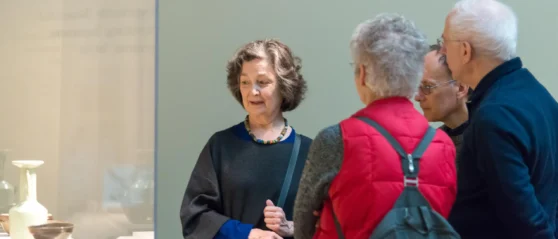Meeting Our Mentors

October 02, 2019 | Grace Chung
When you visit an art museum, you might see objects worth far more than your college debt. You might encounter a gaggle of tourists taking selfies or sidestep a security guard who gives you a wary side-eye look. Sure, you could come upon all of these things while perusing the galleries, but have you ever wondered what happens behind the scenes? Who acquires the art? Who plans and sets up the displays? How does this all get done?
Enthralled by these questions, I was determined to learn more about the objects in the National Museum of Asian Art collections. To start this quest, I met Louise Cort, the museum’s curator emeritus of ceramics. Since she joined the Smithsonian in 1981, she has extensively researched Asian ceramics, from ancient sites in Southeast Asia to the nuances of the Japanese tea ceremony.

As we walked in the quiet corridors of the Freer Gallery, she told me how she first discovered her interest in Asian art. In high school, she lived in Japan as part of a summer study abroad program. She was amazed by the variety and beauty of Japanese art. She wanted to learn more about Japanese art and culture when she returned to America. I can only hope that one day I’ll have a life-changing experience on par with her own trip to Japan!
Next up, I toured the Japanese galleries with Frank Feltens, Japan Foundation Assistant Curator of Japanese Art. I vaguely recall skimming through Japan’s Heian era in my AP world history textbook, and I know very little about the literature and art of Japan. Luckily, Dr. Feltens introduced me to the Tale of Genji, one of the world’s first novels. Scenes from this popular story were often reinterpreted on folded screens.
Dr. Feltens described how different colors were made from crushed minerals. He also explained that Japanese noblemen sometimes requested the figures have indistinguishable faces so viewers could imagine themselves as part of the scene. His insight was fascinating, and I couldn’t help but ask more questions about the work he showed me that day.
All in all, I felt truly honored to meet not one but two curators at the National Museum of Asian Art. I was in awe of their dedication and perspectives on Asian art and culture, and I was inspired by their personal stories and knowledge. When I get to college, I’ll try to take a class in Japanese art so I can continue my exploration of East Asian art!

Grace Chung is a senior at McLean High School in Virginia. She is a three-year member of the Teen Council and loves learning about art and history. In high school she serves as a class council member, director for Relay for Life, and variety quiz bowl captain. Some of her favorite things are tea, jokes, and creating art.
As a member of the Teen Council, I have met bimonthly with a group of teenagers from high schools across the DC area. We talk about museums, culture, and art, and we also plan a teen night at the National Museum of Asian Art, the Smithsonian’s Asian art museums.
Part of my time is spent with my teen mentor, Dr. Antonietta Catanzariti, a scholar of ancient Near Eastern art. I was paired with Dr. Catanzariti due to my interest in Islamic art. We meet once a month to talk about her work, my interests, and her job as a curator. I imagined a curator plans exhibitions and converses about art all day. After learning about Dr. Catanzariti’s work, I now realize there is much more to her job, from research to site visits. Yes, it is true that some of a curator’s time is filled with planning exhibitions, but Dr. Catanzariti recently traveled to Uzbekistan to visit the Karakalpakstan State Museum of Art (called the Nukus Museum) and help its curators take care of the diverse collections. The Russian-born artist Igor Savitsky (1915–1984) founded the Nukus Museum, and today it has the greatest collection of avant-garde Russian art outside of Russia. Who knew? In spending time with Dr. Catanzariti, I have found that professions in the art world are much more than what they seem. Yes, curators plan and organize exhibitions, but they do so much more than that.
Jake Morton is a junior at Bethesda-Chevy Chase High School in Bethesda, Maryland. A member of the National Honor Society, his favorite subjects are history and English. He likes to cook, play tennis, and read in his free time.

